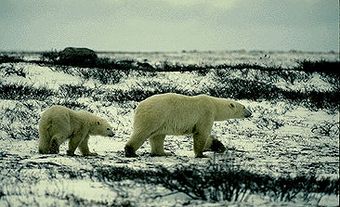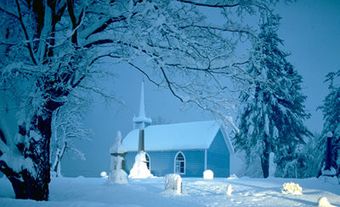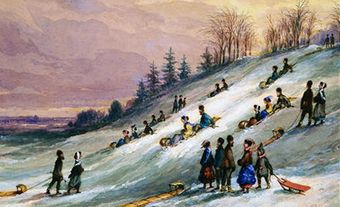In addition to the hardships of establishing themselves in a new land, the enormous toil involved in clearing and cultivating vast areas of wilderness and establishing the formal societal structures that would enable them to cooperatively survive in a new and unfamiliar environment, Canada's early settlers were faced with a climate unlike any that many of them had experienced in their places of origin. Winter in the new land was particularly severe and bleak and of a duration that many would have found especially challenging. Short days and limited sunlight would only add to the depressing environment and limiting recreational activities to the indoors would amplify the imprisoning effect of the season. The solution then as today was to devise activities that would not simply defy the elements, but would exploit the possibilities of snow and ice. These would include snowshoeing and sledding, ice skating and various winter games.
Today, winter activities still include all of these, but in addition may involve much more elaborate things, organized sports events involving large groups of players and even larger groups of spectators, and, especially in the last half century, winter festivals that illustrate the wisdom of accepting that the best way to deal with winter in all of its power and severity is to embrace and celebrate it.
The Québec Winter Carnival - Canada's Oldest Winter Festival

The Québec custom of gathering together before Lent in celebrations from the end of January until mid-February is one of the province's longest traditions, beginning in the earliest days of New France. From this, Canada's first and eventually largest and most popular winter carnival, the Québec Winter Carnival, had its origins. The first large winter carnival in Quebec city was held in 1894, inspired by an idea presented by Frank Carrell, the owner of the Quebec Daily Telegraph, who used the columns of his newspaper to popularize the proposal. The two World Wars, and then the economic crisis of the Great Depression, prevented the festival from being held as an annual event, but in1954, with the economic development of the Old Capital, the event was re-launched. With the first official edition of the Québec Winter Carnival occurring in 1955, the comical figure of Bonhomme Carnaval was created as the symbol of the festivities.
From its earliest manifestation as a rowdy celebration by the citizens of New France intended to interrupt the tedium of winter, the Festival has expanded its scope, over the years adding activities such as winter sports, snow sculptures, and events based on the traditional Québec lifestyle, such as canoe and dogsled races. Organizers have sought to exploit the possibilities of the season and maintain the interest of festival-goers and over the years activities that have been explored have included barrel-jumping, speed skating competitions, motorcycle racing on the ice, chess tournaments and moustache-growing competitions.
Certain events have become staples, and today, the main traditions continue. The Carnival is still held in the first couple of weeks of February and Bonhomme still reins as the ambassador to the festivities. The creation of an ice palace, built to honour Bonhomme, is a major project requiring two months to construct, the canoe race and the snow sculpture competition continue to delight visitors from around the world, making the Québec Winter Carnival and event to rival other major world festivals, including the New Orleans and Rio de Janiero Mardi Gras carnivals.
Festival on the Canal
Ottawa's Winterlude Festival takes place on the Rideau Canal, renamed the Rideau Canal Skateway for the winter months when the river becomes a 7.8 km skateway, as well as at Jacques Cartier Park, Festival Plaza at Ottawa City Hall, and Confederation Park. Winterlude, started by Ottawa's National Capitol Commission in 1979, occurs over the first three weekends in February. In addition to skating activities on the Skateway, the festival features a number of outdoor events, including music and entertainment at the American Express Snowbowl, ice carving and snow sculpture competitions, an igloo building workshop, the "Snowflake Kingdom" (situated in Jacques-Cartier Park in Gatineau), offering horse-drawn sleigh rides, a snow maze, tobogganing and over thirty giant snow slides. Other winter activities occur throughout Ottawa-Gatineau, including special museum exhibits, the Keskinada Loppet (the largest cross-country ski racing event in Canada) and the Canadian Ski Marathon extending 160 kilometres between Gatineau and Lachute, Québec.
Winter Light Festivals
A staple of the Christmas season is the Christmas lights displays that decorate family Christmas trees in many homes. Light displays are a frequent theme for Canadian winter festivals as well. With the long nights of winter, light festivals can have a particularly spectacular effect.
The CAA Winter Festival of Lights in Niagara Falls, Ontario features three million tree lights with over 120 animated displays. Several years ago, the city began introducing LED technology for its displays which are spread along the 5 kilometre Niagara Parkway lighting area (renamed for the occasion the Niagara Parks Winter Wonderland) and in other locations throughout the City. These include Candy Cane Lane in the Lundy's Lane Tourist Area, the Fallsview Tourist Area, Santa's Village on Queen St in the Downtown Arts & Entertainment Area and in the city's Cummington Square. The Festival, which also features fireworks over the Falls, concerts and children's performances, runs from the beginning of November to the first week of January.
The winter light theme features in several other Canadian winter festivals. One of the longest running of these (over 40 years) is Toronto's Cavalcade of Lights. Sited primarily at Nathan Phillips Square, the festival begins with the lighting of the huge Christmas tree with its 100 000 lights and features fireworks, concerts, a projection installation, ice skating as well as lighting displays in more than a dozen Toronto neighbourhoods. Vancouver's Festival of Lights, held in the last three weeks of December, features more than 20 000 lights and displays installed in the city's Van Dusen Botanical Gardens.
The Montreal High Lights Festival, begun in 1999, occurs in the last two weeks in February and features a collection of winter-themed activities along with an emphasis on culinary opportunities involving numerous restaurants where visitors can take advantage of special fixed price menus devised by guest chefs. A highlight of the festival is the "Nuit Blanche," an evening spectacle featuring over 150 events, most of them free to the public.
Winter Celebrations in Canada's North
Canada's indigenous peoples have for many generations devised methods of dealing with the tedium and punishing relentlessness of the Northern winter. Many of these activities pre-date European conquest and with the growth of permanent communities in the North have been formalized into regular festival events that have a particularly Northern character. One of the longest established and most interesting of these is the Arctic Winter Games, begun in 1970 and held every year in the Spring, hosted by different communities each year. Not so much a winter festival as a sporting event designed to promote cultural exchange and community, the Games nevertheless serve to bring relief from the tedium and isolation created by winter in the north. They involve traditional winter games such as hockey, cross-country skiing and snowboarding, supplemented by challenge events derived from the everyday tasks of northern Inuit and Dene life.
Participatory challenge events figure strongly in many other Northern festivals, including the Fitz-Smith Loppet, a one-day event held in March in which participants ski the beautiful trail between Fort Fitzgerald and Fort Smith, NWT, and also the Ivakkak, Nunavik Dogsled Race, a ten-day challenge following a 400 kilometres trail between Kangiqsujuaq and Akulivik. The Hudson's Bay Quest is a 400k dog sled race from Churchill, MA to Arviat, NU held annually in March. The Yukon Quest sees dog teams following a trail that traces historic Gold Rush and mail delivery dog sledding routes from the turn of the 20th century. Scheduled over two weeks in mid-winter, Quest mushers guide their dog teams through some of the most pristine and beautiful wilderness remaining in North America between Whitehorse, Yukon and Fairbanks, Alaska, a journey of some 1600 k.
Less involved in participatory competition and more with community fun is Yellowknife's Snowking Winter Festival which runs through the month of March, with special events each weekend, including the Frozen Dog Film Festival, the Block 1000 rock and roll bash and the Snowking's Royal Ball.
A Growing Trend
Over the last decade, virtually every community in the country has evolved its own version of a winter carnival or festival. They range from the large, such as the Québec Winter Carnival to the very small, such as the Lake Louise Ice Magic Festival, a snow-carving competition held annually over three days in late January. Festivals can be found in St Boniface MA (the Festival du Voyageur), Calgary (Winterfest) and Edmonton (Winter Light) and new ones are arriving every winter season proving that winter is a season to be celebrated, not just endured.

 Share on Facebook
Share on Facebook Share on X
Share on X Share by Email
Share by Email Share on Google Classroom
Share on Google Classroom







